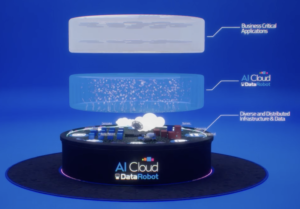At its AIX 2022 conference this week, DataRobot announced new products and enhancements for its AI Cloud platform for data scientists, business users, MLOps, and DevOps.
DataRobot says its AI Cloud can centralize the management of a broad spectrum of data: text, visual, time series, geospatial, and relational. AI Cloud can access disparate data stores on multiple clouds to be managed all in one place. The company claims over 1,000 businesses are supported by it globally.
For data scientists who love to code, the company announced a preview of its Code-First notebooks which are fully integrated with the DataRobot AI Cloud. The company calls this a development space that was purpose-built for data scientists. Data professionals can code with Python tools like pandas, scikit-learn, or NumPy. For MLOps, users can leverage DataRobot’s own Composable ML or bring their own custom ML model or pipeline into DataRobot with full collaboration capabilities.
For business users, DataRobot has expanded its No-Code AI Apps. The company claims it has integrated time series and geospatial data abilities for building predictive analytics applications that are completely explainable with zero coding.
Last year, the company introduced a Solution Accelerator program meant to drive successful AI initiatives. This program has been expanded with new assets including deployment guides, execution templates, sample code, notebooks, configurations for auto pilots, and synthetic data. The Solution Accelerator portfolio allows users to choose from these customer-validated assets while building applications which the company says can help users get from concept to deployment “in a few clicks.”
During a demonstration in the AIX 2022 keynote, Jillian Schwiep, director of product management, said: “In one click, I have access to code for every step, end-to-end, in a single DataRobot notebook. There is code to set up my environment and data, fit and score the full suite of DataRobot models, generate predictions in real time, and export those predictions to a location of my choosing, like Snowflake, an S3 bucket, or an app. I can then deploy this directly into DataRobot’s AI Cloud.”
Bias in AI is another area DataRobot has addressed with a new product called Bias Mitigation. The company says this is needed due to 1/3 of businesses they surveyed reporting lost revenue, legal fees, and lost customers as impacts of bias in AI models. This tool is meant to make AI models more fair, allowing companies to prevent harm from biased models before it occurs by correcting the models before they are moved to production and deployment.
The company also announced several enterprise MLOps expansions for mission critical operations to ensure accuracy and regulatory compliance.
“AI platforms today need to operate as a fully open system, integrating, and interoperating with a broad variety of tools and services, so we are expanding the Ops side of our platform this year,” said Brian Bell, senior director of MLOps product management, in the AIX keynote. “We are focused on delivering complete enterprise operations for all parts of the model lifecycle. This means opening up the platform with even more API support and continuing to support IT.” To that end, AI Cloud is now integrated with GitHub, Sumo Logic, Splunk, Datadog, and Zendesk to better meet customers’ operational needs.
For enterprises with more distributed needs who are deploying models on multiple clouds, on-prem, or edge environments, DataRobot introduced management agents for remote deployments. For customers who need to manage their models “anywhere and everywhere,” this Snowflake-integrated tool allows centralized governance of all models, and it includes the capability of quickly generating compliance documentation.
For DevOps, DataRobot is previewing an expansion of its CI/CD capabilities with new support for GitHub actions which it says will increase efficiency and quality.
“We’re adding new plug and play GitHub actions that can be easily triggered by any event within your GitHub repo. When a data scientist prepares a pull request with a new model version, DataRobot will automatically prepare testing data, perform a new CI build or container with all dependencies, and then verify that the model works as expected in different situations,” said Bell.
DataRobot says these new capabilities are available now or are coming soon, and to make them even more accessible, the company also announced its AI Cloud is now available on Google Cloud Marketplace. “Customers now can seamlessly leverage DataRobot AI Cloud with Google Cloud’s vast library of unique services, including BigQuery, Looker, Vertex AI and others, to build and train models, deploy them in production across cloud and on-premises, and manage them from a single pane of glass. This move meets a growing market demand as companies want to make the most of their data no matter where it resides,” the company said.
“In order to thrive in today’s market, customers must have the ability to deliver AI where their data resides,” said Debanjan Saha, President and COO, DataRobot. “By expanding our strategic partnership with Google Cloud, and joining Google Cloud Marketplace, we’re meeting our customers where they are; enabling them to accelerate and scale as industry innovators, with a seamless experience across cloud platforms.”
Related Items:
Investment in Machine Learning Keeps Growing, DataRobot Finds
DataRobot Nabs $300M, Algorithmia
DataRobot Refreshes AI Platform, Nabs Zepl
The post DataRobot Introduces Expanded AI Cloud Capabilities and Tools appeared first on Datanami.



0 Commentaires